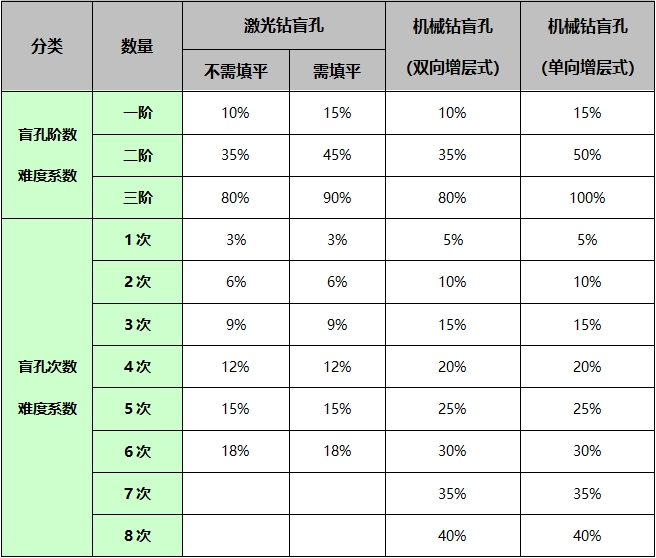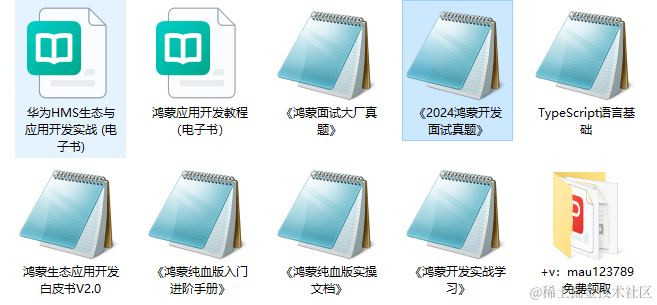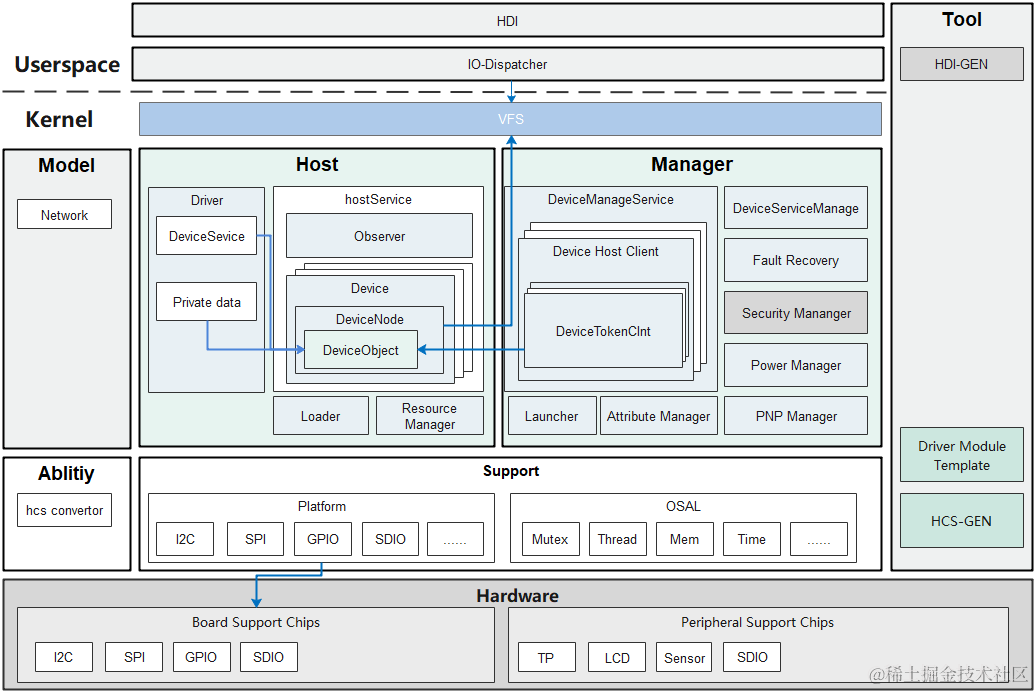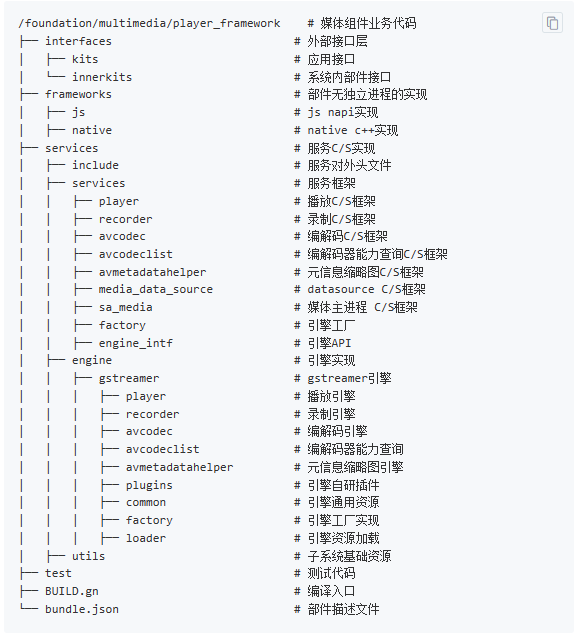HDI接口概述
回顧之前的文章,HDF 驅(qū)動(dòng)框架的一個(gè)重要功能是為系統(tǒng)提供穩(wěn)定的統(tǒng)一的硬件接口,這樣才能保證系統(tǒng)服務(wù)可以運(yùn)行在不同硬件上而不需要額外的適配工作,HDI(Hardware Device Interfaces)正是為了實(shí)現(xiàn)該目的而設(shè)計(jì)。
HDI 是對(duì)硬件功能的較高層次抽象接口,各類外設(shè)完成 HDI 接口定義后便只會(huì)在 HDI 的兼容性規(guī)則下進(jìn)行變更,從而保證接口的穩(wěn)定性。具體的驅(qū)動(dòng)實(shí)現(xiàn)不需要再重復(fù)定義 HDI 接口,只需要按需實(shí)現(xiàn)即可接入系統(tǒng)功能。
在不同量級(jí)的 OpenHarmony 系統(tǒng)上,HDI 存在兩種部署形態(tài),IPC 模式和直通模式。
在輕量級(jí) OpenHarmony 系統(tǒng)上,出于減小系統(tǒng)性能負(fù)載考慮,HDI 實(shí)現(xiàn)為用戶態(tài)共享庫,由系統(tǒng)服務(wù)直接加載 HDI 實(shí)現(xiàn)到自己進(jìn)程中函數(shù)調(diào)用使用。HDI 實(shí)現(xiàn)封裝具體的用戶態(tài)-內(nèi)核態(tài)交互過程,當(dāng)需要訪問驅(qū)動(dòng)程序時(shí)使用 IO Service 請(qǐng)求將消息通過 system call 方式調(diào)用到內(nèi)核驅(qū)動(dòng)實(shí)現(xiàn)。
在標(biāo)準(zhǔn) OpenHarmony 系統(tǒng)上,HDI 以獨(dú)立服務(wù)進(jìn)程方式部署,系統(tǒng)服務(wù)只加載 HDI 客戶端實(shí)現(xiàn)到自己進(jìn)程中,實(shí)際業(yè)務(wù)運(yùn)行在獨(dú)立進(jìn)程中,客戶端通過 IPC 與服務(wù)端交互,便于架構(gòu)解耦、權(quán)限管理。
HDI接口實(shí)現(xiàn)
直通模式為函數(shù)實(shí)現(xiàn)方式,無論調(diào)用還是實(shí)現(xiàn)都不需要其他組件支持即可實(shí)現(xiàn),這里將重點(diǎn)分析 IPC 模式的實(shí)現(xiàn)。
HDI發(fā)布
HDI IPC 模式基于 OpenHarmony 系統(tǒng)通信框架的通用模型,但是因?yàn)轵?qū)動(dòng)很多時(shí)候涉及到底層操作和多系統(tǒng)遷移的場(chǎng)景而使用C語言編寫,所以驅(qū)動(dòng)框架還提供了 HDI 服務(wù)的 C 語言實(shí)現(xiàn)的基礎(chǔ)組件,C++實(shí)現(xiàn)則主要使用系統(tǒng)通信框架組件。
HDI 服務(wù)發(fā)布基于 UHDF(用戶態(tài) HDF 驅(qū)動(dòng)框架)實(shí)現(xiàn),通用的服務(wù)發(fā)布實(shí)現(xiàn)如下。
1. 實(shí)現(xiàn)驅(qū)動(dòng)入口
int SampleDriverBind(struct HdfDeviceObject *deviceObject){HDF_LOGE("SampleDriverBind enter!");static struct IDeviceIoService testService = {.Dispatch = SampleServiceDispatch, // 服務(wù)回調(diào)接口};deviceObject->service = &testService;return HDF_SUCCESS;}int SampleDriverInit(struct HdfDeviceObject *deviceObject){HDF_LOGE("SampleDriverInit enter");return HDF_SUCCESS;}void SampleDriverRelease(struct HdfDeviceObject *deviceObject){HDF_LOGE("SampleDriverRelease enter");return;}struct HdfDriverEntry g_sampleDriverEntry = {.moduleVersion = 1,.moduleName = "sample_driver",.Bind = SampleDriverBind,.Init = SampleDriverInit,.Release = SampleDriverRelease,};HDF_INIT(g_sampleDriverEntry);
首先要添加一個(gè) UHDF 驅(qū)動(dòng)用于發(fā)布 IoService 服務(wù),IoService 設(shè)備服務(wù)即為 HDI 服務(wù)實(shí)體。實(shí)現(xiàn)方式與 KHDF 驅(qū)動(dòng)一致。
2. 實(shí)現(xiàn)服務(wù)響應(yīng)接口
int32_t SampleServiceOnRemoteRequest(struct HdfDeviceIoClient *client, int cmdId,struct HdfSBuf *data, struct HdfSBuf *reply){switch (cmdId) {case SAMPLE_SERVICE_PING:return SampleServiceStubPing(client, data, reply);… …default:HDF_LOGE("SampleServiceDispatch: not support cmd %d", cmdId);return HDF_ERR_INVALID_PARAM;}}static int32_t SampleServiceDispatch(struct HdfDeviceIoClient *client, int cmdId,struct HdfSBuf *data, struct HdfSBuf *reply){return SampleServiceOnRemoteRequest(client, cmdId, data, reply);}
當(dāng)收到 HDI 調(diào)用時(shí),服務(wù)響應(yīng)接口"SampleServiceDispatch"將會(huì)被調(diào)用。
- client 調(diào)用者對(duì)象,在用戶態(tài)驅(qū)動(dòng)中暫時(shí)未支持
- cmdId 調(diào)用命令字,用于區(qū)分調(diào)用的 API
- data 調(diào)用入?yún)⑿蛄谢瘜?duì)象,在 IPC 調(diào)用場(chǎng)景為 parcel 對(duì)象的 C 語言封裝,入?yún)⑿枰褂眯蛄谢涌趶?data 對(duì)象中獲取后再使用
- reply 調(diào)用出參對(duì)象,需要返回給調(diào)用的信息寫入該序列化對(duì)象
如果 C++實(shí)現(xiàn)客戶端可以使用下面接口將 sbuf 對(duì)象轉(zhuǎn)換為 parcel 對(duì)象后操作:
int32_t SbufToParcel(struct HdfSBuf *sbuf, OHOS::MessageParcel **parcel);
3. UHDF 驅(qū)動(dòng)配置platform :: host {hostName = "sample_host";priority = 50;sample_device :: device {device0 :: deviceNode {policy = 2;priority = 100;moduleName = "libsample_driver.z.so";serviceName = "sample_driver_service";}}}
參數(shù)說明:
- host 一個(gè) host 節(jié)點(diǎn)即為一個(gè)獨(dú)立進(jìn)程,如果需要獨(dú)立進(jìn)程,新增屬于自己的 host 節(jié)點(diǎn)
- policy 服務(wù)發(fā)布策略,HDI 服務(wù)設(shè)置為 2
- moduleName 驅(qū)動(dòng)實(shí)現(xiàn)庫名
- serviceName 服務(wù)名稱,請(qǐng)保持全局唯一性
因?yàn)?HDI 服務(wù) C 和 C++實(shí)現(xiàn)使用的 IPC 組件不一樣,面向?qū)ο髮?shí)現(xiàn)也不一致,所以在具體實(shí)現(xiàn)上存在一些差異。
HDI基礎(chǔ)組件UHDF 框架為了支持 HDI 實(shí)現(xiàn),提供了以下基礎(chǔ)組件(僅用于 C 語言 HDI 實(shí)現(xiàn)):-
SBuf
SBuf 是同時(shí)支持 KHDF 和 UHDF 驅(qū)動(dòng) IoService 消息序列化的工具對(duì)象。在 UHDF IPC 通信場(chǎng)景中,SBuf 可以與系統(tǒng) IPC 框架序列化對(duì)象 MessageParcel 對(duì)象(僅支持 C++)相互轉(zhuǎn)換,從而實(shí)現(xiàn) C 和 C++實(shí)現(xiàn)的 IPC 互通。
常用 API 如下:
struct HdfSBuf;struct HdfSbufImpl;struct HdfRemoteService;/*** @brief HdfSBuf類型定義。** @since 1.0*/enum HdfSbufType {SBUF_RAW = 0, /* 用于用戶態(tài)內(nèi)核態(tài)通信的sbuf類型 */SBUF_IPC, /* 用于跨進(jìn)程通信的sbuf類型 */SBUF_IPC_HW, /* 用于擴(kuò)展的預(yù)留類型 */SBUF_TYPE_MAX, /* sbuf類型最大值 */};

上述接口均有對(duì)應(yīng)的寫入接口,不再一一列舉,可查閱官網(wǎng)API參考文檔。
-
RemoteService
基于 RemoteService 實(shí)現(xiàn)一個(gè)服務(wù)端的示例:// 消息分發(fā)器,用于服務(wù)端響應(yīng)調(diào)用或者在客戶端發(fā)起調(diào)用struct HdfRemoteDispatcher {int (*Dispatch)(struct HdfRemoteService *, int, struct HdfSBuf *, struct HdfSBuf *);};// RemoteService 死亡回調(diào)對(duì)象struct HdfDeathRecipient {void (*OnRemoteDied)(struct HdfDeathRecipient *, struct HdfRemoteService *);};struct HdfRemoteService {struct HdfObject object_;struct HdfObject *target;struct HdfRemoteDispatcher *dispatcher;bool isHw;};// 以自定義的消息分發(fā)器實(shí)例化一個(gè)RemoteServicestruct HdfRemoteService *HdfRemoteServiceObtain(struct HdfObject *object, struct HdfRemoteDispatcher *dispatcher);// 回收RemoteService對(duì)象void HdfRemoteServiceRecycle(struct HdfRemoteService *service);// 添加RemoteService的死亡通知,如果對(duì)應(yīng)RemoteService的進(jìn)程異常退出,HdfDeathRecipient的回調(diào)接口將被調(diào)用voidHdfRemoteServiceAddDeathRecipient(structHdfRemoteService*service,structHdfDeathRecipient*recipient);
int SampleServiceStubDispatch(struct HdfRemoteService* service, int code, struct HdfSBuf *data, struct HdfSBuf *reply){// IPC 調(diào)用響應(yīng)接口int ret = HDF_FAILURE;switch (code) {case SAMPLE_IF_0: {// do somethingbreak;}default: {ret = HDF_ERR_INVALID_PARAM;}}return ret;}bool SampleStubConstruct(){// 構(gòu)造消息分發(fā)器,實(shí)現(xiàn)消息處理回調(diào)static struct HdfRemoteDispatcher dispatcher = {.Dispatch = SampleServiceStubDispatch};// 實(shí)例化RemoteServiceinst->remote = HdfRemoteServiceObtain((struct HdfObject *)inst, &dispatcher);if (inst->remote == NULL) {HDF_LOGE("Device service manager failed to obtain remote service");return false;}……
直接基于 RemoteService 實(shí)現(xiàn)服務(wù)端只適用于需要實(shí)現(xiàn)匿名 IPC 服務(wù)的情況,基于 UHDF 發(fā)布 HDI 服務(wù)只需要實(shí)現(xiàn) Driver 綁定的 IoService 即可。
RemoteService 客戶端對(duì)象只能從 SBuf HdfSBufReadRemoteService 接口獲取。
HDI實(shí)現(xiàn)
- Driver 為 HDI 服務(wù)的驅(qū)動(dòng)入口實(shí)現(xiàn)
- IoService 為 HDI 服務(wù)的服務(wù)入口實(shí)現(xiàn),IoService 的 Dispatch 方法中調(diào)用 ServiceStub 中的真正服務(wù)響應(yīng)接口(OnRemoteRequest)
- ServiceStub 為服務(wù)端實(shí)現(xiàn)對(duì)象,主要處理與 IPC 相關(guān)的業(yè)務(wù)邏輯,在這里完成參數(shù)反序列化后調(diào)用真正的 Service 實(shí)現(xiàn)接口,即 ServiceImpl 接口
- ServiceImpl 為 HDI 接口的真正實(shí)現(xiàn),這里不關(guān)注 IPC 過程,只實(shí)現(xiàn)函數(shù)接口。
- 驅(qū)動(dòng)框架提供了實(shí)現(xiàn)的樣例代碼,可參考 gitee driver 代碼倉。
HDI接口調(diào)用
HDI驅(qū)動(dòng)框架HDI接口HDI 服務(wù)管理功能由驅(qū)動(dòng)框架 DeviceManager 實(shí)現(xiàn),所以驅(qū)動(dòng)框架提供了 HDI 服務(wù)管理相關(guān) HDI 接口。
C++實(shí)現(xiàn):
namespace OHOS {namespace HDI {namespace ServiceManager {namespace V1_0 {struct IServiceManager : public IRemoteBroker {public:DECLARE_INTERFACE_DESCRIPTOR(u"HDI.IServiceManager.V1_0");// get()靜態(tài)方法用于獲取IServiceManager對(duì)象實(shí)例static ::sptrGet(); // GetService()接口是真正提供的HDI接口,用于查詢并獲取其他HDI服務(wù)的客戶端對(duì)象virtual ::sptrGetService(const char* serviceName) = 0; };} // namespace V1_0} // namespace ServiceManager} // namespace HDI}//namespaceOHOS
C 實(shí)現(xiàn):
extern "C" {struct HDIServiceManager {struct HdfRemoteService *remote;struct HdfRemoteService *(*GetService)(struct HDIServiceManager *self, const char* serviceName);};struct HDIServiceManager *HDIServiceManagerGet(void);void HDIServiceManagerRelease(struct HDIServiceManager *servmgr);}
C 語言因?yàn)槿鄙僭拿嫦驅(qū)ο笾С郑@里我們采用 OOC 的實(shí)現(xiàn),函數(shù)方法 HDIServiceManagerGet/Release 用于 HDIServiceManager 對(duì)象的實(shí)例化和釋放,HDI 接口關(guān)聯(lián)在接口對(duì)象內(nèi)部成員中,與 C++實(shí)現(xiàn)類似。
HDI客戶端實(shí)現(xiàn)
HDI 客戶端同時(shí)支持 C 和 C++實(shí)現(xiàn),實(shí)現(xiàn)方法較為簡(jiǎn)單,只需 realize HDI 接口類即可。提供 C++實(shí)現(xiàn)基于系統(tǒng) IPC 子系統(tǒng)的統(tǒng)一模型,C 語言基于 RemoteService 和 SBuf 組件實(shí)現(xiàn),但是有一些公共的約定:
1. 客戶端提供接口對(duì)象,接口與對(duì)象綁定且必須與 HDI 一致
2. 提供服務(wù)接口對(duì)象的實(shí)例化和釋放接口。
3. 客戶端實(shí)現(xiàn) IPC 過程,只為調(diào)用者暴露函數(shù)化接口。
HDI接口調(diào)用
HDI 客戶端接口已經(jīng)提供了服務(wù)獲取接口,調(diào)用者調(diào)用服務(wù)獲取接口后再調(diào)用服務(wù)對(duì)象方法即可完成 HDI 調(diào)用。
這里以服務(wù)管理 HDI 接口為例:
C++接口調(diào)用:
void GetTestService(){auto servmgr = IServiceManager::Get();if (servmgr == nullptr) {HDF_LOGE("failed to get IServiceManager");return;}auto sampleService = servmgr->GetService(TEST_SERVICE_NAME);if (sampleService == nullptr) {HDF_LOGE("failed to get TEST_SERVICE");return;}// do something}
C 接口調(diào)用:
void GetTestService(){struct HDIServiceManager *servmgr = HDIServiceManagerGet();if (servmgr == nullptr) {HDF_LOGE("failed to get IServiceManager");return;}struct HdfRemoteService *sampleService = servmgr->GetService(servmgr, TEST_SERVICE_NAME);if (sampleService == nullptr) {HDF_LOGE("failed to get TEST_SERVICE");return;}// do something}
總結(jié)
本文介紹了 HDI 的總體方案,重點(diǎn)介紹了 HDI 的 IPC 模式具體實(shí)現(xiàn)方法和驅(qū)動(dòng)框架能力,相信對(duì)讀者理解和使用 HDI 有所幫助。
-
HDI
+關(guān)注
關(guān)注
6文章
200瀏覽量
21315 -
C++
+關(guān)注
關(guān)注
22文章
2110瀏覽量
73689 -
代碼
+關(guān)注
關(guān)注
30文章
4793瀏覽量
68701 -
OpenHarmony
+關(guān)注
關(guān)注
25文章
3725瀏覽量
16375
原文標(biāo)題:OpenHarmony HDF HDI基礎(chǔ)能力分析與使用
文章出處:【微信號(hào):HarmonyOS_Community,微信公眾號(hào):電子發(fā)燒友開源社區(qū)】歡迎添加關(guān)注!文章轉(zhuǎn)載請(qǐng)注明出處。
發(fā)布評(píng)論請(qǐng)先 登錄
相關(guān)推薦
OpenHarmony程序分析框架論文入選ICSE 2025

HDI盲埋孔工藝及制程能力你了解多少?

HDI盲埋孔工藝及制程能力你了解多少?
HDI板盲孔制作常見缺陷及解決
PCB HDI產(chǎn)品的介紹

松下伺服驅(qū)動(dòng)器速度模式參數(shù)設(shè)置方法
鴻蒙開發(fā):【OpenHarmony 4.0 Release指導(dǎo)】

開發(fā)者手機(jī) AI - 目標(biāo)識(shí)別 demo
OpenHarmony南向能力征集令
鴻蒙開發(fā)實(shí)戰(zhàn):【Hdf Framework】

OpenHarmony4.0源碼解析之媒體框架

鴻蒙OS跨進(jìn)程IPC與RPC通信
OpenHarmony 之 NAPI 框架介紹





 OpenHarmony HDF HDI的IPC模式具體實(shí)現(xiàn)方法和驅(qū)動(dòng)框架能力
OpenHarmony HDF HDI的IPC模式具體實(shí)現(xiàn)方法和驅(qū)動(dòng)框架能力










評(píng)論